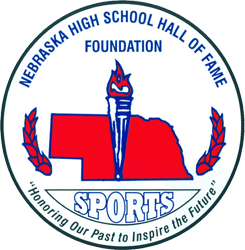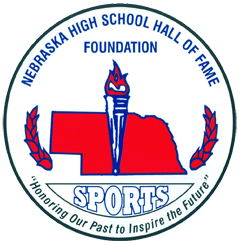Athlete–One of the most nationally known of all Omaha high school graduates, this Benson High product (Class of 35) became a football legend. His athletic skills were abundantly clear, for he starred in track & field, was named all-state in football and helped Benson nearly reach the top in Class A basketball.
Attending college at the University of Iowa, Nile Kinnick was awarded the Heisman Trophy in 1939 for his outstanding efforts on behalf of the Hawkeyes. In his acceptance speech at the Heisman dinner, Kinnick reflected the prevailing isolationist mood of the country, saying he thanked God he had been born in America “where they have football fields instead of in Europe where they have battlefields.” And he added that he knew “the football players of this country had rather battle for such medals as the Heisman Trophy than for such medals as the Croix de Guerre and the Iron Cross.” Sadly, he was lost while a Naval flier during World War II. Today several gridirons in both Nebraska and Iowa bear his name as a true competitor and
Nile Kinnick is said to be one the Hawkeyes’ greatest football players. In his football career gained 1,674 yards. In his senior year, he completed 31 passes for 638 yards; over three years were good for 2,834 yards, an average of 39.9 yards per kick. His return of kickoffs and punts totaled 604 yards, and he made 11 of his 17-drop kick attempts.
Nile was elected to the National Football Foundation and College Hall of Fame in 1951.
Nile Kinnick, Halfback Iowa, 1937-1939
Much stock has been put into the legendary aspect of the player and what he meant to his school and to college football. No player in college football history meant more to a whole state than Nile Kinnick meant to Iowa becoming its most popular hero and is still today its most revered icon. If you want the ultimate model of what a student/athlete should be, Kinnick was it as a Heisman winner on the football field and a honor student and class president off of it.
The Iron man of Iron Men: Iowa football wasn’t exactly a power in the world of college football in the 1930s as its neighbor to the north, Minnesota, was busy owning the Midwest. After going 2-13-1 and scoring a total of 82 points in 1937 and 1938, Dr. Eddie Anderson took over the head coaching job and Iowa went on to have a season for the ages winning games in dramatic fashion with a group of two way players outlasting several big-time powerhouses with specialists on offense and defense.
Kinnick had a flair for the dramatic making the game-winning play against Indiana choosing to throw for a fifteen yard touchdown pass rather than try the game-tying field goal. After an early 27-7 loss to Michigan, he took care of Wisconsin on a late touchdown pass for 19-13 win. Losing player after player to injury, Iowa had only 14 healthy players late against Purdue in the 4-0 win. Iowa upset No. 1 Notre Dame 7-6 using only 15 players with Kinnick punting 16 times for 731 yards including a 63-yard boot under a heavy rush pinning the Irish on the six-yard line late in the game. Many still consider it the greatest clutch punt in college football history. Kinnick also scored Iowa’s only touchdown. The following week the “Iron man” team of Iowa upset the might Minnesota squad 13-9.
The Iron Man of the Iron Man team played 402 consecutive minutes before getting knocked out of the Northwestern game with a separated shoulder. Kinnick was the star of the show all year throwing for 638 yards and 11 touchdowns on only 31 passes and ran for 374 yards. In his career he gained 1,674 yards returning kickoffs for 604 yards. As a kicker, Kinnick punted 71 times in his career for a 39.9 average and hit 11 of 17 drop kicks. In 1939, Kinnick was involved in 16 of the 19 touchdowns (11 passing, 5 rushing) Iowa scored and responsive for 107 of Iowa’s 130 points.
The Heisman speech: In perhaps the most eloquent Heisman speech ever given, Kinnick finished with this epic passage. “If you will permit me, I’d like to make a comment which in my mind is indicative, perhaps, of the greater significance of football, and sports emphasis in general in this country, and that is, I thank God I was warring on the gridirons of the Midwest, and not on the battlefields of Europe. I can speak confidently and positively that the players of this country, would much more, much rather struggle and fights to win the Heisman award, than the Croix de Guerre.”
The “big” man on campus: Along with being the star of the football team, Kinnick was senior class president, a Phi Betta Kappa and a member of the national scholastic honor society.
The World War II fighter: Following his Iowa career, Kinnick chose to go to law school and join the Naval Air Corps Reserve. In 1943, Kinnick’s fighter plane went down in the Caribbean sea on a training flight. In 1972, the University changed the name of Iowa Stadium to Kinnick Stadium to honor their hero.
Honors:
- College Football Hall of Fame – 1951
- Heisman Trophy – 1939
- Walter Camp Award – 1939
- Maxwell Award – 1939
- All-America – 1939
- Big Ten MVP – 1939
- No. 24 Iowa jersey retired
- Selected the greatest player in Iowa history by the fans – 1989

